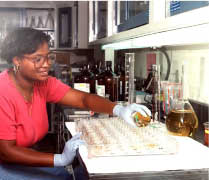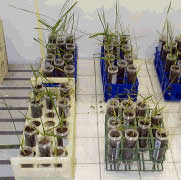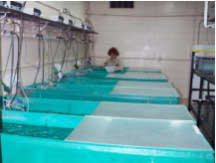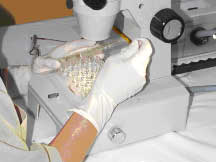Biosciences Division

Environmental Toxicology Laboratory
The Oak Ridge National Laboratory’s (ORNL) Environmental Toxicology Laboratory (ETL) provides Department of Energy (DOE) Facilities with on-site capabilities for toxicity testing of environmental media and toxicant identification evaluation (TIE). Bioassay techniques developed and validated at the ETL, including soil toxicity tests as well as aquatic tests, have been successfully applied in environmental compliance monitoring and assessment activities and in experimental applications for DOE, DoD, and other Federal agencies.
Facilities and Resources
 The ETL is fully staffed and equipped to conduct compliance-based and experimental toxicity tests with freshwater and marine aquatic organisms and terrestrial organisms. ORNL Environmental Sciences Division (ESD) research staff scientists with pertinent expertise in ecotoxicology, genomics, ecology, risk assessment, physiology, physical chemistry, biochemistry, and hydrology are available for consultation and collaboration. The ETL presently cultures Ceriodaphnia dubia, Daphnia magna, Hyalella azteca, Chironomis tentans, medaka, zebrafish, and earthworms and obtains other test organisms from commercial suppliers as needed. A high quality, temperature controlled source of water is available using extensive charcoal filtration followed by distillation and deionization. Three laboratories comprising over 1,800-square-feet house bench top space, environmentally controlled chambers and water baths, and animal culture areas. In-house water quality analysis capabilities include measurements of conductance, hardness, alkalinity, pH, and total and residual chlorine. The adjacent 8,000 square-foot Aquatic Ecology Laboratory of the Environmental Sciences Division houses extensive areas for fish and macroinvertebrate culture and processing, and is served by temperature-controlled filtered stream water, dechlorinated process water, and well-water. A set of indoor artificial streams, which have been used for projects sponsored by the National Science Foundation and DOE, contain eight replicate channels and allow control over key environmental factors such as discharge, light exposure and water temperature. Sampling equipment, boats and a vehicle fleet are available.
The ETL is fully staffed and equipped to conduct compliance-based and experimental toxicity tests with freshwater and marine aquatic organisms and terrestrial organisms. ORNL Environmental Sciences Division (ESD) research staff scientists with pertinent expertise in ecotoxicology, genomics, ecology, risk assessment, physiology, physical chemistry, biochemistry, and hydrology are available for consultation and collaboration. The ETL presently cultures Ceriodaphnia dubia, Daphnia magna, Hyalella azteca, Chironomis tentans, medaka, zebrafish, and earthworms and obtains other test organisms from commercial suppliers as needed. A high quality, temperature controlled source of water is available using extensive charcoal filtration followed by distillation and deionization. Three laboratories comprising over 1,800-square-feet house bench top space, environmentally controlled chambers and water baths, and animal culture areas. In-house water quality analysis capabilities include measurements of conductance, hardness, alkalinity, pH, and total and residual chlorine. The adjacent 8,000 square-foot Aquatic Ecology Laboratory of the Environmental Sciences Division houses extensive areas for fish and macroinvertebrate culture and processing, and is served by temperature-controlled filtered stream water, dechlorinated process water, and well-water. A set of indoor artificial streams, which have been used for projects sponsored by the National Science Foundation and DOE, contain eight replicate channels and allow control over key environmental factors such as discharge, light exposure and water temperature. Sampling equipment, boats and a vehicle fleet are available.
Capabilities and Example Applications
 Development of test methods involving novel applications — The ETL has developed and applied conventional, near-conventional, or highly modified Ceriodaphnia and fathead minnow larvae test methods to unique situations. We devised a highly-modified Ceriodaphnia test method, for example, to determine the toxicity of groundwater contaminated with volatile and semivolatile pollutants. A near-conventional test method using Ceriodaphnia was used to assess the biological quality of particulate matter exiting a settling basin near the Oak Ridge Y-12 Plant, and a highly modified 7-day fathead minnow test procedure was used to determine the source of an unusual pattern of replicate-to-replicate variation in fathead minnow survival in ambient-water tests. To determine the acute toxicity of synthetic fuel constituents, we developed a rapid algal-photosynthesis test that is especially well suited for generating rapid dose-response data for large numbers of chemicals. In 1995, we developed a soil test that can be used to measure the effects of soil pollutants on earthworm survival, growth and reproduction. To help estimate ecological risk of contaminants in sediments, we also developed testing capabilities with the aquatic midge, Chironomus tentans. We used seed-germination tests and earthworm tests together to provide data supporting an ecological risk assessment for the Portsmouth Gaseous Diffusion Plant, and to conduct a baseline characterization investigation of Bear Creek Valley on the Oak Ridge Reservation. The ETL has developed other bioassay techniques to address specific needs of Department of Energy facilities, including a rapid 3-day snail-feeding assay using the amount of food consumed as a test endpoint. For more complex situations, multi-species mesocosm-scale tests may be used to provide weight-of-evidence information useful in an ecological risk-assessment context (demonstrated in a project sponsored by the U.S. Army Environmental Center: Gunderson, et al. 1997). We are currently developing methods for detecting waterborne hazards by DNA microrarrays and genetically modified organisms.
Development of test methods involving novel applications — The ETL has developed and applied conventional, near-conventional, or highly modified Ceriodaphnia and fathead minnow larvae test methods to unique situations. We devised a highly-modified Ceriodaphnia test method, for example, to determine the toxicity of groundwater contaminated with volatile and semivolatile pollutants. A near-conventional test method using Ceriodaphnia was used to assess the biological quality of particulate matter exiting a settling basin near the Oak Ridge Y-12 Plant, and a highly modified 7-day fathead minnow test procedure was used to determine the source of an unusual pattern of replicate-to-replicate variation in fathead minnow survival in ambient-water tests. To determine the acute toxicity of synthetic fuel constituents, we developed a rapid algal-photosynthesis test that is especially well suited for generating rapid dose-response data for large numbers of chemicals. In 1995, we developed a soil test that can be used to measure the effects of soil pollutants on earthworm survival, growth and reproduction. To help estimate ecological risk of contaminants in sediments, we also developed testing capabilities with the aquatic midge, Chironomus tentans. We used seed-germination tests and earthworm tests together to provide data supporting an ecological risk assessment for the Portsmouth Gaseous Diffusion Plant, and to conduct a baseline characterization investigation of Bear Creek Valley on the Oak Ridge Reservation. The ETL has developed other bioassay techniques to address specific needs of Department of Energy facilities, including a rapid 3-day snail-feeding assay using the amount of food consumed as a test endpoint. For more complex situations, multi-species mesocosm-scale tests may be used to provide weight-of-evidence information useful in an ecological risk-assessment context (demonstrated in a project sponsored by the U.S. Army Environmental Center: Gunderson, et al. 1997). We are currently developing methods for detecting waterborne hazards by DNA microrarrays and genetically modified organisms.
 Effluent testing — ETL activities were initially directed to effluent testing. These tests demonstrate environmental compliance of waste treatment operations according to criteria stipulated in National Pollutant Discharge Elimination System permits for the Oak Ridge National Laboratory, the Oak Ridge Y-12 Plant (now the Y-12 National Security Complex), and the Oak Ridge Gaseous Diffusion Plant (now the East Tennessee Technological Park). In providing this assistance, the ETL has more than twenty years of experience and expertise in conducting EPA-approved acute and chronic tests with water-fleas (particularly, Ceriodaphnia dubia and Daphnia magna) and fish (primarily fathead minnow larvae). We have used these tests to characterize effluents and monitor the toxicity of non-treated waste waters, cooling tower blow-down, and chemically complex effluents from various specialty wastewater treatment systems.
Effluent testing — ETL activities were initially directed to effluent testing. These tests demonstrate environmental compliance of waste treatment operations according to criteria stipulated in National Pollutant Discharge Elimination System permits for the Oak Ridge National Laboratory, the Oak Ridge Y-12 Plant (now the Y-12 National Security Complex), and the Oak Ridge Gaseous Diffusion Plant (now the East Tennessee Technological Park). In providing this assistance, the ETL has more than twenty years of experience and expertise in conducting EPA-approved acute and chronic tests with water-fleas (particularly, Ceriodaphnia dubia and Daphnia magna) and fish (primarily fathead minnow larvae). We have used these tests to characterize effluents and monitor the toxicity of non-treated waste waters, cooling tower blow-down, and chemically complex effluents from various specialty wastewater treatment systems.
Ambient water-quality testing — The ETL pioneered the use of 7-day, static-renewal tests with Ceriodaphnia and fathead minnow larvae for characterizing the biological quality of receiving streams. This unique expertise initially was used to support stream biological monitoring programs for three DOE facilities in Oak Ridge, Tennessee. The procedures involved novel statistical techniques for relating physico-chemical water-quality conditions to ambient toxicity. The ambient testing program is extensive, involving some 45 sites on nine streams over a fifteen-year period. Additional testing procedures utilizing fish embryos have been developed and remain in current use. The techniques and significant findings from the use of these ambient-testing procedures have been described in various publications, some of which are attached.
 Toxicity identification/reduction evaluation (TI/REs) — The ETL developed excellent capabilities for toxicity identification/reduction evaluations. This expertise was urgently needed due to the chemical complexity and potential for unique pollutants in many of the effluents from the DOE facilities. The techniques for toxicant identification ultimately were used to definitively identify the following materials as significant toxicants in waste waters: depleted uranium; nickel; zinc; lithium; chlorine; an organic dye in a classified process; copper; sodium sulfate; and calcium. The ETL’s expertise in testing and toxicant identification are widely recognized and have been used to support the needs of other DOE facilities, including DOE gaseous diffusion plants in Kentucky and Ohio, and the DOE Kansas City Plant, in Kansas City, Missouri.
Toxicity identification/reduction evaluation (TI/REs) — The ETL developed excellent capabilities for toxicity identification/reduction evaluations. This expertise was urgently needed due to the chemical complexity and potential for unique pollutants in many of the effluents from the DOE facilities. The techniques for toxicant identification ultimately were used to definitively identify the following materials as significant toxicants in waste waters: depleted uranium; nickel; zinc; lithium; chlorine; an organic dye in a classified process; copper; sodium sulfate; and calcium. The ETL’s expertise in testing and toxicant identification are widely recognized and have been used to support the needs of other DOE facilities, including DOE gaseous diffusion plants in Kentucky and Ohio, and the DOE Kansas City Plant, in Kansas City, Missouri.
Work for other Federal Agencies — The expertise in toxicity testing that was developed with DOE funding to support DOE needs subsequently was made available to other federal agencies on an “as needed” basis. ETL testing services have been supplied to the Tennessee Valley Authority, characterizing microbiocidal chemicals used in cooling-tower operations, and the U.S. Army, conducting water-leachate toxicity tests of battery fragments needed to provide guidance for decision-makers about the advisability of land disposal of various types of batteries. We used Ceriodaphnia tests to determine the toxicity of U.S. Navy hydroblasting operations on ships in Pearl Harbor, and fathead minnow larvae tests to determine the toxicity of pesticide-tainted groundwater for the Massachusetts Department of Natural Resources. We also used Ceriodaphnia tests to determine the toxicity of trinitrotoluene (TNT) and TNT degradation products, thus supporting research on the feasibility of a soil-slurry bioreactor technology developed by the U.S. Army Environmental Center.
For more information, contact:
Mark S. Greeley (greeleyms@ornl.gov, 865-574-9387)

